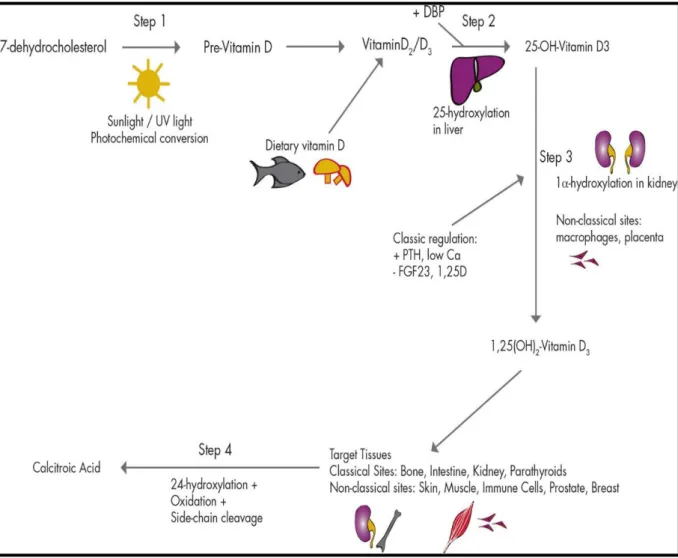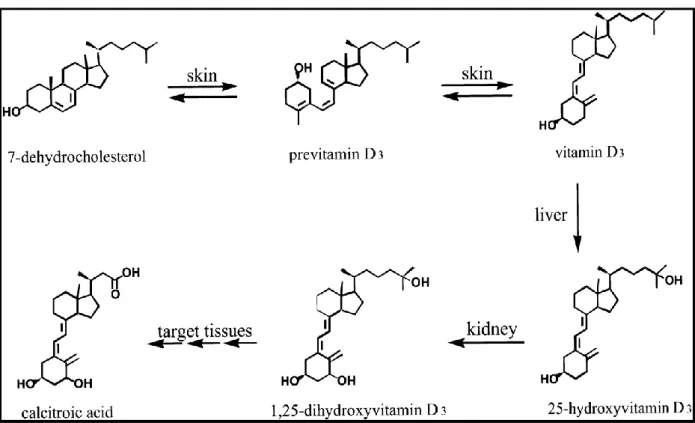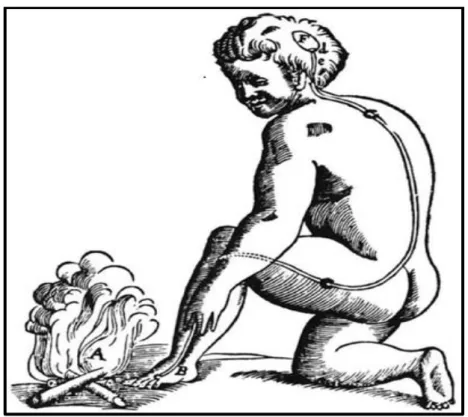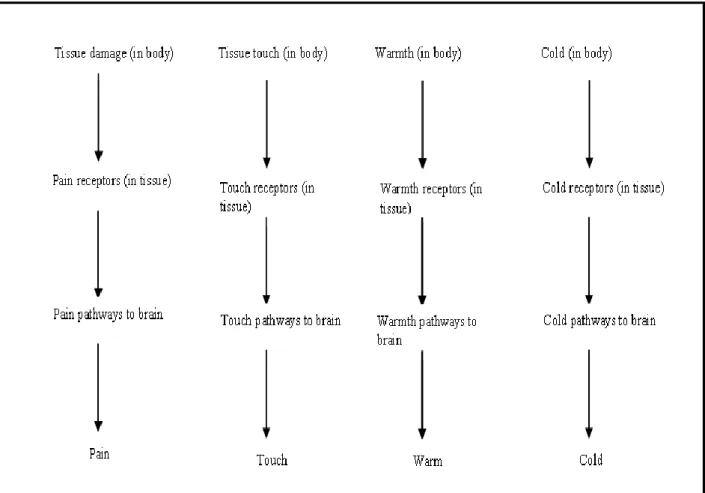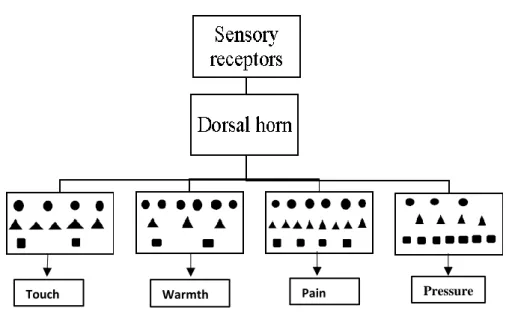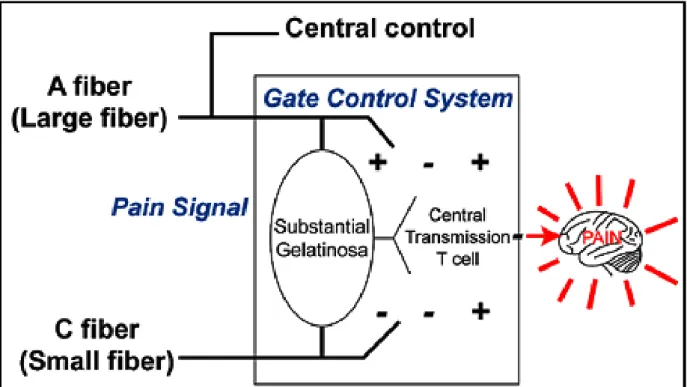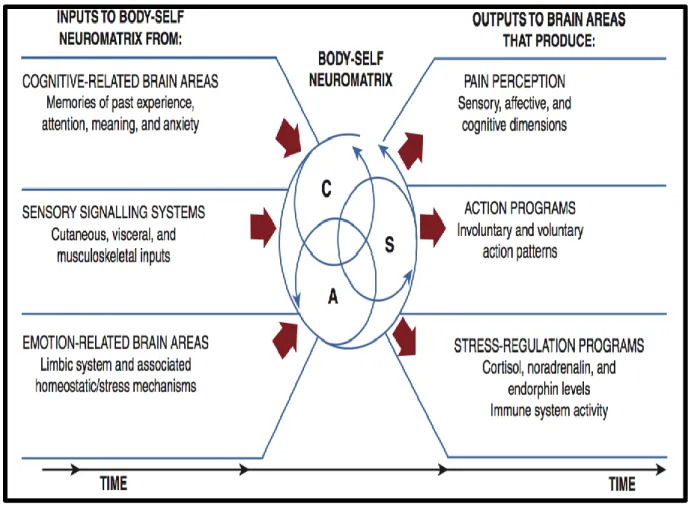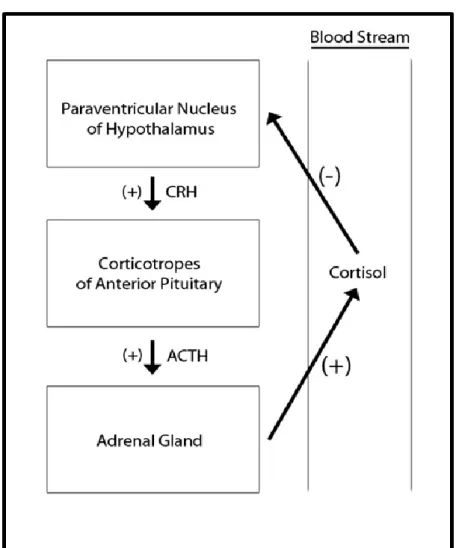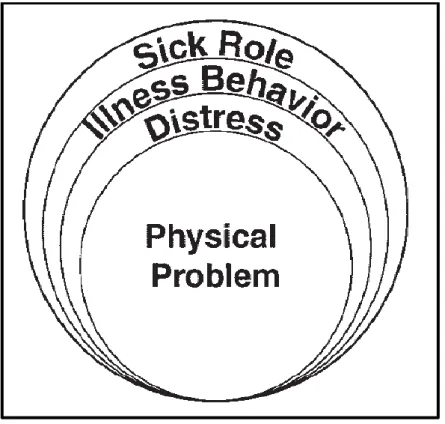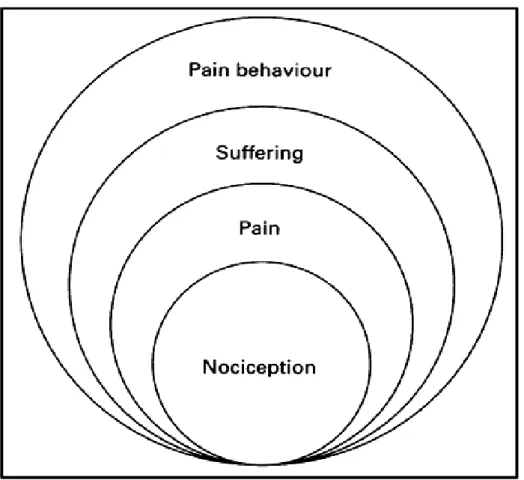i
Vitamin D deficiency and its role in chronic nonspecific musculoskeletal pain
Manasi Murthy Mittinty
MD (Medicine), GradDip Mag Reson Tech
Thesis submitted in fulfilment of the requirement for the degree of Doctor of Philosophy
August 2017
Discipline of General Practice School of Medicine
The University of Adelaide
Australia
ii
iii
THESIS SUMMARY --- vii
Declaration ---xiii
Publications contributing to this thesis --- xiv
Conference presentation arising from this thesis ---xv
Research Translation (Media Coverage) arising from this thesis --- xvi
Awards arising out of this thesis --- xvii
Acknowledgments --- xviii
Abbreviations & Acronyms ---xx
List of Figures --- xxiii
List of Tables --- xxiv
CHAPTER 1 --- 1
1.1. Introduction --- 2
1.2. Thesis Aim --- 4
1.3. Thesis Outline --- 5
CHAPTER 2 --- 7
2.1 Vitamin D --- 8
2.1.1. Synthesis of Vitamin D --- 9
2.1.2. Calcium homeostasis ---11
2.1.3. Vitamin D receptors ---12
2.1.4. Evaluating Vitamin D status ---13
2.1.5. Level of Vitamin D in Australian Population ---13
2.1.6. Interpretation of circulating vitamin 25 (OH) D levels ---14
2.2. Chronicles of Pain ---16
2.2.1. The Biomedical model of pain ---17
2.2.2. The Specificity Theory ---18
2.2.3. The Pattern theory ---20
2.2.4. The Gate Control Theory of Pain ---21
2.2.5. The Neuromatrix model of Pain ---23
2.2.6 The Biopsychosocial Model ---26
2.2.7. Current theoretical concept of pain ---28
2.2.8. Mechanism of Pain ---29
2.2.9. Peripheral nerve injury ---30
2.3. Musculoskeletal conditions and the role of vitamin D ---32
iv
2.3.3 Chronic widespread pain ---45
2.3.4 Fibromyalgia ---49
2.3.5. Chronic non-specific musculoskeletal pain ---54
CHAPTER 3 ---65
3.1 Preface ---66
Characteristics of Chronic Pain in Australia ---66
Economic Impact ---68
Chronic nonspecific musculoskeletal pain ---70
3.2 Abstract ---73
3.3 Introduction ---74
3.4 Purpose ---75
3.5 Methods ---75
3.6 Results ---77
3.7 Discussion ---84
3.8 Conclusion ---86
CHAPTER 4 ---85
4.1 Preface ---86
4.3 Abstract ---94
4.4 Background ---95
4.5 Methods ---96
Search strategy: ---97
4.6 Results --- 102
4.7 Discussion --- 106
CHAPTER 5 --- 110
5.1 Preface --- 111
5.3 Abstract --- 113
5.4 Introduction --- 115
5.5 Aim & Objectives --- 116
5.6 Methods --- 117
5.7 Analysis --- 120
5.8 Measures --- 121
5.9 Dissemination --- 122
5.10 Discussion --- 123
v
6.3 Introduction --- 128
6.4 Methods --- 129
6.5 Results --- 133
6.6 Discussion --- 141
6.7 Conclusion --- 144
CHAPTER 7 --- 146
7.1 Preface --- 147
7.2 Abstract --- 148
7.3 Introduction --- 150
7.4 Aim and Objectives --- 151
7.5 Methods --- 152
7.6 Results --- 156
7.7 Discussion --- 167
7.8 Conclusion --- 170
CHAPTER 8 --- 171
8.2 Synthesis of the findings --- 179
8.3 Limitations --- 179
8.4 Concluding remarks --- 181
8.5 Directions for Future studies --- 182
REFERENCES--- 181
APPENDIX --- 211
vi
vii
BACKGROUND
Pain is a universal and costly medical health problem. It is estimated that approximately one in ten individuals develop chronic pain each year. Chronic pain is among the top 10 complaints for which individuals seek help from primary care health professionals. In spite of its prevalence, doctors report a lack of confidence in managing chronic painful conditions.
Moreover, the use of opioids for non-malignant chronic pain has increased recently and has become more regulated. Not surprisingly there is a high demand for alternative treatment options for managing chronic pain.
Chronic nonspecific musculoskeletal pain (CNMP) is a type of chronic pain, marked by the absence of a clear patho-physiological or anatomical origin. CNMP causes major disruption to patients’ lives, relationships, and functionality. A rising prevalence of CNMP is observed in the general population but especially in children and adolescents. A diagnosis of CNMP early in life is recognized as a predictor for disability later. The limited information on its etiology, diagnosis and management perplexes doctors and patients alike.
There is a growing body of evidence that suggests vitamin D deficiency may play an important role in the etiology of CNMP. The discovery of vitamin D receptors in most tissues and cells in the human body and the identification of non-classical functions support the potential involvement of vitamin D in multiple chronic painful conditions including CNMP. In addition, vitamin D deficiency, by itself, is also reported as a major public health concern. Therefore because vitamin D supplementation is cheap and safe, it is increasingly being used as a management option. However the evidence base for such treatment is limited.
viii
know if supplementing vitamin D deficiency might improve symptomatology for patients with CNMP. In addition, very little is known about patient’s perspectives, beliefs and views of their chronic pain management, especially in relation to vitamin D testing and supplementation, pain education and the patient-provider relationship. Patient perspectives are fundamental for identifying areas of management which require improvement to achieve better treatment outcomes.
AIM
The overall aims of this thesis is to provide evidence about,
1. The diagnosis and management of CNMP in Australian general practice and the role, if any, of vitamin D deficiency and supplementation in its etiology and treatment respectively.
2. The perspectives of patients with chronic pain about their medical management, investigations and vitamin D supplementation.
The research objectives are:
Objective 1- What management strategies do GPs employ with patients presenting with CNMP?
Objective 2- How effective is vitamin D supplementation in the management of CNMP?
Objective 3- What demographic and pain-related factors are associated with; testing for vitamin D levels, vitamin D deficiency and intake of vitamin D supplement among people with chronic pain?
ix
recovery?
METHODS
For the objective 1 focus groups were used to explore and contrast in-depth accounts of GP’s experience in Australia. As GPs’ are often the first medical experts to start management for CNMP patients, their perspectives are critical for improving diagnosis and management. We wanted to understand their approach to managing CNMP and the role, if any, of vitamin D testing and supplementation. Ethical approval was granted by the Human Research Ethics Committee, University of Adelaide (HS-2013-056). Individual informed consent was collected at the beginning of each focus group. Twenty-seven general medical practices of varying size and socioeconomic patient mix in Adelaide and surrounding areas were invited to participate.
Five practices with 23 GP’s consented and participated in the study. The focus groups were audio recorded, transcribed using Nvivo 10 and analyzed thematically.
For the objective 2, a systematic review of the literature and meta-analysis was undertaken of studies published up to November 2015. Only randomized controlled trials investigating vitamin D supplementation compared with placebo were included. Studies using other designs and concurrent interventions along with vitamin D supplementation were excluded in order to study the direct effect of vitamin D. Following PRISMA guidelines, PubMed, Embase, Web of Science, Cochrane, and Scopus electronic databases were searched for randomized controlled trials comparing vitamin D supplementation to a control or placebo in CNMP patients; the search was not limited by language or date. All studies were independently reviewed using a standardized form. Jadad score was used to assess the quality of the studies included. The main outcome (pain) was measured using visual analogue scale (VAS). The mean change in VAS from baseline was considered as the primary pain outcome measure.
x
random effect models were used in meta-analysis to properly account for heterogeneity in the studies. metan software in STATA was used for estimating the combined and overall effect.
For the objectives 3 and 4, a cross-sectional study using Survey Monkey was conducted to understand the perspectives of individuals with chronic pain about their pain management.
Ethical approval was granted by the Human Research Ethics Committee, University of Adelaide (HREC-2016-0712) and the University of South Australia (application id- 0000035791). The survey was completely voluntary and anonymous. The survey collected demographic data and included questions about the following; the participant’s medical history, pain-related factors (pain intensity, duration and characteristics of pain), pain education, goals from chronic pain management, patient’s perception of recovery time and vitamin D supplement intake. The analysis was performed using STATA 14.1 Statistical software. A range of statistical approaches were used for analysis these include; descriptive analysis for depicting the profiles of patients, logistic regression for estimating odds ratio, and least absolute shrinkage and selection operator (LASSO) technique.
RESULTS
In the first study, five main themes were identified: the ambiguous etiology of CNMP; gender differences; developing the “right strategy”; patient centered care; and verifying vitamin D levels. GPs adopt a patient-centered approach tailored to individual patients’ medical history, physical examination and psychosocial health. GPs’ recommended vitamin D supplements in patients with CNMP if indicated by a patients’ history.
xi
however twenty-seven studies did not meet our selection criteria and hence were excluded.
Data from the remaining three studies was included in the meta-analysis. A forest plot was used to present the results from the meta-analysis. Moderate – quality evidence suggested no effect of vitamin D supplementation on pain relief (SMD: 0.004; 95% CI: -0.248 to 0.256) in CNMP patients. Because only a small number of moderate quality studies were identified, better designed, large, double blind RCTs conducted over longer periods of time and capturing short, medium and long term effects are called for.
In study three, the estimated sample size was (n) 384 respondents to the survey to have power of 90% and have 5% uncertainty in the effect estimate. A simple prediction model was developed from the data collected using the LASSO regression technique. The findings from this study showed that older age was consistently associated with testing, vitamin D deficiency and intake of vitamin D. Unemployment, being on leave due to pain or in part time employment and being resident of Australia were also associated with vitamin D testing. Higher mean pain intensity score ≥6 on an 11 point numerical rating scale was associated with vitamin D deficiency; and being diagnosed with vitamin D deficiency was associated with intake of vitamin D. Being vitamin D deficient and unemployed on leave or part time employed due to pain were associated with doctor advised vitamin D supplementation.
Using the data collected in the survey study, the effect of pain education and patient-provider relationship on patient-reported pain intensity and recovery was examined using univariate and multivariate logistic regression. The findings from this study showed that individuals aged 40 years and above and female were more likely to report higher pain intensity and poor perception of recovery. Being in part-time employment was also associated with pain intensity and recovery. Pain education and patient-provider relationship did not show an association with
xii
of pain. We therefore hypothesize that pain education has an indirect relationship with patient- reported pain intensity and recovery induced by change in pain cognition and management of pain. The findings also show that individuals who reported good patient-provider relationship were more likely to report positive changes in pain cognition and management of pain.
CONCLUSION
General practitioners in Australia adopt a holistic approach to managing patients’ with CNMP.
They appear recommend vitamin D deficiency based on a person’s history but the role of vitamin D deficiency in CNMP is unclear. The literature contains many studies examining the relationship between vitamin D deficiency and CNMP but only a few that could be included in a meta-analysis. The results demonstrated no evidence of benefit but more studies should be undertaken. Finally, using data from a cross sectional survey, it appears that several demographic and pain-related factors available to doctors are associated with vitamin D deficiency, testing and supplementation and these could be used in a predictive model for patients with chronic pain to rationalize testing and supplementation. More importantly, the pain management strategies for individuals with chronic pain should include education directed towards improving their understanding of pain and individual management.
xiii
This thesis contains no material which has been accepted for the award of any other degree or diploma in any university or other institution and affirms that to the best of my knowledge, the thesis contains no material previously published or written by another person, except where due reference is made in the text of thesis. In addition, I certify that no part of this work will, in the future be used in a submission for any other degree or diploma in any university or other tertiary institution without the prior approval of the University of Adelaide and where applicable, any partner institution responsible for the joint-award of this degree.
I give consent to this copy of my thesis, when deposited in the University Library, being made available for loan and photocopying, subject to the provisions of the Copyright Act 1968.
The author acknowledges that copyright of published works contained within this thesis, (as listed on the next page) resides with the copyright holder(s) of those works.
I also give permission for the digital version of my thesis to be made available on the web, via the University’s digital research repository, the Library catalogue, the Australasian Digital Theses Program (ADTP) and also through web search engines, unless permission has been granted by the University to restrict access for a period of time.
Signed ...
Manasi Murthy Mittinty (Candidate)
Date:
xiv
1. Gaikwad M, Vanlint S, Mittinity M, Moseley GL, Stocks N. Does vitamin D supplementation alleviate chronic nonspecific musculoskeletal pain? A systematic review and meta-analysis. Clinical rheumatology. 2016 Feb 9:1-8.
2. Gaikwad M, Vanlint S, Moseley GL, Mittinty MN, Stocks N. Understanding patient perspectives on management of their chronic pain–online survey protocol. Journal of Pain Research. 2017;10:31.
3. A qualitative exploration of GPs’ perspectives on managing chronic non-specific musculoskeletal pain in Australian general practice- A Focus group study. Family Medicine and Community Health, in press.
xv
1. Gaikwad M, Vanlint S, Alyward P, Stocks N. Chronic nonspecific musculoskeletal pain management: A Doctor’s perspective. The 8th Annual Faculty of Health Postgraduate Research Conference. University of Adelaide, 25th September 2014, Adelaide, Australia.
2. Gaikwad M, Vanlint S, Alyward P, Stocks N. GP’s perspective on managing Chronic Nonspecific Musculoskeletal Pain. The 2015 Australian Pain Society 35th Annual Scientific Meeting, 15-18th March 2015, Brisbane, QLD, Australia
3. Gaikwad M, Vanlint S, Mittinty M, Stocks N. Vitamin D and chronic non-specific musculoskeletal pain: a systematic review. The 2015 New Zealand Pain Society 40th Annual Scientific Meeting, 25-29th March 2015, Auckland, New Zealand.
4. Gaikwad M, Vanlint S, Mittinty M, GL Moseley, Stocks N. Does Vitamin D alleviate chronic non-specific musculoskeletal pain: a systematic review and meta-analysis? The 2016 Australian Pain Society 36th Annual Scientific Meeting, 13 – 16th March 2016, Perth, WA, Australia.
5. Gaikwad M, Vanlint S, Mittinty M, GL Moseley, Stocks N. Does Vitamin D alleviate chronic non-specific musculoskeletal pain: a systematic review and meta-analysis? The 2016 European Pain School, University of Sienna, 5th – 12th June, Sienna, Italy.
6. Gaikwad M, Vanlint S, Mittinty M, GL Moseley, Stocks N. Association of Vitamin D Supplementation and Chronic Non-Specific Musculoskeletal Pain: A Systematic Review and Meta-Analysis. The 16th World Congress on Pain, International Association for the Study of Pain, 25th – 30th September 2016, Yokohoma, Japan.
xvi
1. “Vitamin D for Pain Relief? It Depends”, MedPage Today, 7th February 2017.
(http://www.medpagetoday.com/resource-center/Osteoporosis/Vitamin-D/a/62981) 2. “Standardising an approach to use of Vitamin D supplements in chronic pain relief” ,
ehospice, 7th November 2014
(http://www.ehospice.com/australia/Default/tabid/10688/ArticleId/12949)
3. “GPs should prescribe Vitamin D to treat chronic musculoskeletal pain”, The Lead, 6th November 2014 (australia.com.au/industries/health/gps-should-prescribe-vitamin-d-to- treat-chronic-musculoskeletal-pain/)
4. Vitamin D should be prescribed by doctors to treat chronic musculoskeletal pain, according to research, Inquisitr, 7th December 2014. (http://www.inquisitr.com/1661168/vitamin-d- should-be-prescribed-by-doctors-to-treat-chronic-musculoskeletal-pain-according-to- research/)
5. “GP guidelines should include Vitamin D” National Seniors, 6th November 2014 (http://nationalseniors.com.au/be-informed/news-articles/gp-guidelines-should-include- vitamin-d-say-researchers)
xvii
1. Awarded the prize for best poster from the School of Population health at the 8th Annual Faculty of Health Postgraduate Research Conference.
2. Received travel award to attend the 2015 Australian Pain Society 35th Annual Scientific Meeting, Brisbane.
3. Selected among the top 6 posters presented at the 2015 New Zealand Pain Society 40th Annual Scientific Meeting, Auckland.
4. Received travel award to attend the study at the 2016 Australian Pain Society 36th Annual Scientific Meeting, Perth.
5. Selected among top 30 participants around the world to attend and present work at European Pain School, June 2016, Italy.
6. Awarded School of Medicine travel award to attend the European Pain School 2016, Italy.
7. Received travel award and free registration to attend the 16th World Congress on Pain, International Association for the Study of Pain 2016, Yokohoma, Japan
8. Received Walter and Dorothy Duncan Trust travel award for attending the 16th World Congress on Pain, Japan.
xviii
If we knew what it was we were doing, it would not be called research, would it?
- Albert Einstein
To me that sums up my PhD journey really well! Though I’m full of gratitude for this journey and experience, it is not one without its peaks and valleys. At the final corner of my PhD candidature, I would like to sincerely thank the following people for their guidance, contribution and support.
First I would like to thank my supervisors Nigel Stocks and Simon Vanlint for their guidance and support throughout my PhD years. A special thank you to my supervisor Lorimer Moseley for allowing me to ask many many questions and providing valuable insights.
My mentor, Lisa Jamieson- thank you for all your support, encouragement- one could not ask for a better mentor. Your doors have always been open for me and I am grateful for your guidance and friendship. It has been a great privilege to know you and I look forward to our continued collaboration in research and more.
All my friends at the Better Start Group, Body in Mind and ARCPOH- thank you for listening, offering me advice and supporting me through this entire process.
A big thank you to all the administrative staff of School of Population Health and the Librarian’s (especially Mick Draper) for their help and support and the general practices, organizations and participants who supported my research.
Especial thank you to my Surve uncle and aunty for being a positive influence in my life and providing words of encouragement.
xix
I also acknowledge with great sense of reverence, my gratitude towards my parents and my brother, for their love and support. My dad who always believed in me and supported my crazy ideas. My brother for sharing and backing up all my major moments thus far. And a special thank you to my mother who played a monumental role in helping me achieve my dreams.
My husband Murthy Mittinty, who has been a fantastically supportive, loving and patient partner. I am so lucky to have you in my life – I could not accomplish this feat without you by my side. Thank you for inspiring me every day and making me more than I am.
Finally, I dedicate my thesis to the visionaries who paved the way for girl education and social justice for women in India, namely Dr B.R. Ambedkar and Jyotirao Phule.
xx
ABS The Australian Bureau of Statistics ACPA Anti-citrullinated protein antibody ACR The American College of Rheumatology
ANZBMS Australian and New Zealand Bone and Mineral Society BMD Bone mineral density
BMI Body Mass Index BoD Burden of disease
BOKS Boston Osteoarthritis of the Knee Study Ca Calcium
CHERRIES Checklist for Reporting Results of Internet E-Surveys CI Confidence Interval
CNS Central nervous system
CNMP Chronic nonspecific musculoskeletal pain CRH Corticotrophin-releasing hormone
CWP Chronic widespread pain DAS 28 Disease Activity Score DWL Deadweight losses DBP Vitamin D binding protein ESR Erythrocyte sedimentation rate
xxi
FGD Focus group discussion FPS Functional Pain Score GP General Practitioner
GRADE Grading of Recommendations Assessment, Development and Evaluation HPA Hypothalamic- pituitary-adrenal axis
ICD The International Classification of Diseases IASP The International Association for the Study of Pain K/L scale The Kellgren-Lawerence grading scale
LASSO Least absolute shrinkage and selection operator NHS National health Survey
NHMRC The National Health and Medical Research Council NRS Numerical rating scale
OA Osteoarthritis OR Odds ratio
PRISMA Preferred Reporting Items for Systematic Reviews and Meta-Analyses PTH Parathyroid hormone
QOL Quality of life RA Rheumatoid arthritis
RCT Randomized controlled trial
xxii
SOF The Study of Osteoporotic fractures
SRQR Standards for Reporting Qualitative Research TasOAC The Tasmanian Older Adult Cohort
TENS Transcutaneous electrical nerve stimulation TUG Timed up and go test
VAS Visual Analog Scale VDR Vitamin D receptor
UCLA The University of California, Los Angeles activity scale WPI Widespread pain index
WOMAC The Western Ontario and McMaster Universities Arthritis Index 1,25(OH) D 1, 25-dihyroxyvitamin D
25(OH)D 25-hydroxyvitamin D
xxiii
Figure 2.1 Synthesis of Vitamin D
Figure 2.2 Vitamin D synthesis, activation and catabolism Figure 2.3 Descartes model of pain
Figure 2.4 Schematic representation of the Specificity Theory Figure 2.5 Schematic representation of the Pattern theory Figure 2.6 The Gate control Theory
Figure 2.7 The Neuromatrix model of Pain
Figure 2.8 The Hypothalamic Pituitary Adrenal Axis Figure 2.9 Engel’s conceptual model of illness Figure 2.10 Loeser’s conceptual model of pain Figure 3.1: Prevalence Chronic Pain, Australia 2007 Figure 3.2: Total cost of Chronic Pain to society
Figure 3.3: Total cost of Chronic Pain at an individual level Figure 4.1 Flow chart diagram of study selection
Figure 4.2 Forest plot using fixed effect model Figure 4.3 Forest plot using random effects model
Figure 7.1 Top 5 most referred type of education material Figure 7.2 Top 5 Most useful type of education material
xxiv
Table 3.1: Exemplar quotes for theme 1: ambiguous etiology Table 3.2: Exemplar quotes for theme 2: gender differences
Table 3.3: Exemplar quotes for theme 3: Developing the right strategy Table 3.4: Exemplar quotes for theme 4: patient-centered care
Table 3.5: Exemplar quotes for theme 5: verifying vitamin D levels Table 4.1 Electronic search strategy tailored to each database Table 4.2 Characteristics of Included Studies
Table 4.3 Jadad Scores of included studies
Table 6.1 Distribution of the demographic characteristics of the sample Table 6.2 Summary of LASSO for factors associated with vitamin D testing Table 6.3 Summary of LASSO for factors associated with vitamin D deficiency
Table 6.4 Summary of LASSO for factors associated with intake of vitamin D supplement Table 6.5 Summary of LASSO for factors associated with doctor advised vitamin D supplement
Table 7.1 Self-reported pain intensity by participants aged 18 years and above.
Table 7.2 Unadjusted and Adjusted Odds Ratios for Pain Intensity among individuals with chronic pain aged 18 years and above
Table 7.3 Self-reported recovery according to age among individuals with chronic pain aged 18 years and above (n=448)
xxv
Table 7.5 Unadjusted and Adjusted Odds Ratios for Self-reported changes in pain cognition among individuals with chronic pain aged 18 years and above
Table 7.6 Unadjusted and Adjusted Odds Ratios for Self-reported changes in management of pain among individuals with chronic pain aged 18 years and above
xxvi
1
CHAPTER 1
Introduction
2
1.1. Introduction
According to the National Pain Strategy (1), “One in five Australians, including children and adolescents, will suffer chronic pain in their lifetime and up to 80% of people living with chronic pain are missing out on treatment that could improve their health and quality of life”
(p. 7).
The impact of chronic pain on an individual goes beyond their physical suffering, it causes emotional distress, social isolation, and impacts society through the financial burden of disease via loss of income, medical expenses, and the monetary cost of the disability pension. The economic burden of chronic pain to society is enormous, with current estimates of $150 billion and $200 billion per annum in the USA and Europe, respectively (2). Management of chronic pain still perplexes health professionals and scientists alike due to its complex presentation and multiple co-morbidities (3). For many years chronic pain was considered as either a symptom of underlying disease (4) or a secondary consequence of other medical conditions (5, 6).
However, chronic pain is now widely recognized as a condition in its own right (5). Hence, it is warranted to explore the mechanisms that underlie the development of chronic pain independent of other conditions.
The estimated prevalence of chronic pain in Australia is approximately 20% (7) which is similar to estimates for adult Europeans (8, 9). However, prevalence estimates of chronic pain can often be inaccurate due to differences in the definition of chronic pain (10-13), methods used for data collection (8, 10, 14, 15), if the focus is on a body part or function (11, 16) or pain being associated with a specific condition (12, 17).
Musculoskeletal conditions are reported to be the most common cause of chronic pain (7), with the reported high prevalence of chronic nonspecific musculoskeletal pain (CNMP) ranging between 30-70% (8, 15, 18, 19). According to Pfizer Australia (20), 13% of the Australian
3
population who live with chronic pain have no medical explanation for it. An alarming 20%
have considered suicide with 5% attempting it because of their chronic pain (20).
Chronic pain management forms a significant part of the workload for general practitioners (GPs). GPs are often the primary contact for individuals experiencing pain (21, 22); GPs provide referrals to pain clinics and also the ongoing pain management following discharge from pain clinics (6). Predictably chronic pain is among the top 10 complaints for which individuals seek primary care (7, 23). However, primary care physicians report reduced confidence (24-26) in managing non-malignant chronic pain. They report lack of training and a perceived risk of side effects, substance misuse and concerns about addiction from opioid therapy (24-27). In the past 20 years, the prescription and consumption of opioids for managing chronic pain have increased fifteen-fold in Australia (28-30). This increase is attributed to GPs prescribing opioids for managing non-malignant chronic pain (31). An analysis of 4666 GP visits in Australia (30, 32) found that 43.9% of opioids were prescribed for chronic pain, 3.5%
for malignant neoplasia and the remainder for non-chronic pain and other causes. This rise in opioid prescription by GPs may be due to lack of specialist support, shortage of proven therapies (33, 34), a wish to avoid patients going untreated (34) and to the Medicare model of funding which limits longer consultations (34) which might allow alternate strategies to be discussed and used. The increasing concern about the use of opioids for non-malignant chronic pain has led to heightened vigilance (32, 35), with doctors’ failure to comply with the state legislative requirements for opioid prescription sometimes resulting in disciplinary action (36).
For the above reasons, there is a need for alternative therapies which could help relieve chronic painful conditions. A growing amount of evidence suggests that vitamin D deficiency may play an important role in the pathophysiology of CNMP (37). Vitamin D deficiency is also reported as a major public health concern in Australia with nearly one-third of Australians reported to have low levels (38). Low vitamin D levels have a direct effect on musculoskeletal health (37,
4
39, 40) and may often present as diffuse muscle pain, muscle fatigue, arthralgia, deep bone pain and muscle weakness (41-44). These symptoms are nonspecific and fit the criteria for CNMP. Vitamin D supplementation could alleviate some nonspecific pain and because it is easily available, and inexpensive it could be a safe method of managing CNMP.
The management of CNMP by GPs’ and its perceived relationship with vitamin D deficiency has not been described previously. Nor do we know if correcting vitamin D deficiency could actually improve the pain experienced. This thesis provides evidence about the diagnosis and management of patients with CNMP and the effectiveness of vitamin D supplementation, which may potentially bridge the knowledge gap and help improve treatment outcomes.
Moreover an attempt has been made to obtain insights from patients suffering with chronic pain, about their current pain management strategies and perceived recovery time.
1.2. Thesis Aim
The overall aims of this thesis are to provide evidence about
1) The diagnosis and management of CNMP in Australian general practice and the role, if any, of vitamin D deficiency and supplementation in its etiology and treatment.
2) The perspectives of patients with chronic pain about vitamin D supplementation and their medical management and investigations.
The research objectives are:
Objective 1- What management strategies do GPs employ with patients presenting with CNMP?
Objective 2- How effective is vitamin D supplementation in the management of CNMP?
5
Objective 3- What demographic and pain-related factors are associated with: testing for vitamin D levels, vitamin D deficiency and intake of vitamin D supplement among people with chronic pain?
Objective 4- What perspectives do patients with chronic pain have about the patient-provider relationship, pain education and does it affect their pain intensity and perceived time to recovery?
1.3. Thesis Outline
The remainder of the thesis is organized as follows. Chapter 2 provides the relevant literature that describes context of the specific aims, introduced above. The review covers common chronic painful musculoskeletal conditions, including CNMP, that are seen in Australian general practice. It also examines what role vitamin D deficiency and supplementation may have in each of these conditions. Chapter 3 addresses the first research question, which describes Australian GPs’ decision-making processes when managing CNMP in practice using a focus group study design. This chapter is accepted for publication as a research article in peer-reviewed journal Family Medicine and Community Health.
Chapter 4 addresses the second research question, which examines the effects of vitamin D supplementation on CNMP using a systematic review and meta-analysis of randomized controlled trials (RCTs). This chapter was published as a research article in a peer-reviewed journal (45) (Attached as Appendix).
Chapter 5 presents the methods for a cross-sectional survey of patients with chronic pain, the variables selected to examine patients’ perceptions, views, and beliefs on vitamin D testing, deficiency and supplement intake; pain education; patient-provider relationship; pain intensity and their perception of recovery. Chapter 5 describes in detail the objectives and methodology
6
used in designing and conducting the survey. Chapter 5 is published as a research article in the peer-reviewed Journal of Pain Research (Attached as Appendix).
Chapter 6 addresses the third research question, which examines the patients’ views and beliefs about vitamin D testing, deficiency and supplement intake and the factors associated with medically advised vitamin D supplementation and patients’ perception of recovery. Chapter 6 is under review as a research article in a peer-reviewed journal.
Chapter 7 examines patients’ views and beliefs about patient-provider relationship and pain education, and if there is an association between the patient-provider relationship and pain education and patient reported pain intensity and perception of recovery. This chapter will be prepared for submission to a peer-reviewed journal after completion of the Ph.D.
Chapter 8 provides a summary from the overall thesis, synthesis of the findings, and a proposed plan for future research.
7
CHAPTER 2
Literature Review
8
The structure of this chapter is as follows. Section 2.1 describes the background on vitamin D, its synthesis, metabolism and guidelines on interpreting vitamin D levels in clinical practice.
Section 2.2 reviews pain, and the journey from the Biomedical model to the current Biopsychosocial model of pain. Section 2.3 describes the effects of vitamin D on chronic pain conditions such as osteoarthritis (OA), rheumatoid arthritis (RA), chronic widespread pain (CWP), fibromyalgia (FM) and chronic nonspecific musculoskeletal pain (CNMP), and on how vitamin D levels might relate to or modulate CNMP.
2.1 Vitamin D
In 1919, Sir Edward Mellanby proposed a deficiency of a fat-soluble vitamin or accessory food factor (46) as the cause for the development of rickets in children. He fed a diet consisting only of oats to a group of dogs restrained indoors without any sun exposure. He produced rickets in these dogs through the restrictive diet. He then fed the dog’s cod-liver oil, which is not present in oats, and the dogs were cured of rickets. He attributed the treatment success to vitamin A present in the cod liver oil. In 1922, McCollum and associates performed a test of bubbling oxygen through cod liver oil, which burned out the vitamin A, leaving behind a “new substance” that remained effective in treating rickets. They labelled this new substance in the oil - “vitamin D” following sequential alphabetical designations (47). Labelling of this substance as a vitamin is often questioned, as vitamin D acts more like a hormone than a vitamin. Also unlike any other vitamins, vitamin D can be synthesized in the human body. It is acknowledged as a fat-soluble hormone precursor, which is produced by exposure to adequate sunlight. In 1928, a German structural chemist Adolf Windus won the Nobel Prize for the chemical identification and synthesis of vitamin D (48). Two forms of vitamin D are recognized
9
namely; vitamin D2 [ergocalciferol] found in plants and some fish and vitamin D 3 [cholecalciferol] synthesized in the skin from direct exposure to the sunlight (49).
2.1.1. Synthesis of Vitamin D Cutaneous synthesis of vitamin D
On exposure of the skin to sunlight (UV-B rays), pre-vitamin D3 is synthesized in the skin from 7-dehyroxycholesterol (see Figure 2.1). Multiple factors such as the amount of UV exposure (290-315 nm wavelength), skin pigmentation and thickness, age, latitude, season, and level of sun protection used (including clothing, shade, and sunscreen) regulate this step.
Previtamin D3 is isomerized to vitamin D3, which binds to the vitamin D binding protein (DBP) (48) and is transported into the liver. In the liver, it is hydroxylated by the 25- hydroxylase enzyme to 25-hydroxyvitamin D [25(OH) D] which is the inactive form.
Subsequently, in the proximal convoluted tubules of the kidneys, 25-hydroxyvitamin D is hydroxylated by the enzyme 1 α-hydroxylase to 1,25-dihydroxyvitamin D [1,25 (OH)2D], the physiologically active form (50-52). This cutaneous synthesis of vitamin D supplies 80-100%
of the daily requirement of vitamin D (53).
Exogenous synthesis (synthesis of dietary vitamin D)
Vitamin D can be ingested from food sources such as eggs, oily fish, liver, unfortified butter and fortified foods like milk, margarine, cereals, juice, and yoghurt (54). This orally ingested vitamin D2 also binds to DBP and is transported to the liver from where it follows the path of cutaneous synthesis (48).
10
2.1.2. Vitamin D metabolism
Figure II2 Molecular structures of various compounds of vitamin D pathway from synthesis to metabolism (55).
The hydroxylation steps in vitamin D metabolism, 25-hydroxylation, 1α-hydroxylation, and 24- hydroxylation are all controlled by cytochrome P450 mixed function oxidases (CYPs).
Figure 2.1 Synthesis of Vitamin D (48)
Both 25 (OH) D and 1, 25(OH) D undergo 24-hydroxylation to form 24, 25 (OH) D and 1, 24, 25 (OH) D respectively (56), which is the initial stage of biodegradation that ends in the formation of water-soluble calcitroic acid (56, 57). The hydroxylation of vitamin D in the liver is almost unregulated therefore serum level of 25(OH) D can reflect either cutaneous production in the skin or dietary intake and is hence used as the marker for vitamin D status (57, 58). The only regulated step in the synthesis of the active form of vitamin D is the production of 1, 25(OH) D by the kidney (51).
11
The wide-ranging effects of vitamin D are also attributed to the extra-renal expression of the enzyme 1 α-hydroxylase in tissues of skin and brain (50) and also in the cells of osteoclasts, macrophages (59), breast, colon, prostate (60) and smooth muscle (61). They can locally synthesize the active form of vitamin D (61). This pre-vitamin D3 is biologically inert and needs to undergo two successive hydroxylation’s to become biologically active (see Figure 2.2).
Figure 2.2 Vitamin D synthesis, activation and catabolism (55).
2.1.2. Calcium homeostasis
A flux of calcium between bone, kidney, intestine and extracellular fluid regulates plasma concentration of calcium. This flux is predominantly controlled by 3 major hormones:
12
parathyroid hormone (PTH), calcitonin and 1, 25-dihyroxyvitamin D. These hormones also form a negative feedback control for maintaining calcium levels (62). The parathyroid hormone (PTH) is regulated by the serum calcium (Ca), phosphorus (P) levels (61), growth hormone and prolactin (63). The normal concentration of PTH, phosphate, and calcium regulate the central point in vitamin D metabolism - the renal hydroxylation of 25- hydroxyvitamin D to 1,25- dihydroxyvitamin D. Though decrease in PTH and phosphate levels independently increase 1,25-hydroxyvitamin D production, PTH is the most potent stimulus (64). Rising levels of 1, 25-dihydroxyvitamin D increases the plasma concentration of calcium and phosphate by increasing the absorption of calcium and phosphate from the gastrointestinal tract (50-52). It also increases osteoclastic reabsorption of calcium and enhances the effects of PTH in the nephron to promote renal tubular calcium reabsorption. Thus, 1,25-dihydroxyvitamin D regulates calcium and phosphate deposition and release from bone (64).
2.1.3. Vitamin D receptors
There are two known forms of the vitamin D receptor (VDR), namely nuclear VDR and membrane bound VDR. The most thoroughly described are the nuclear VDR, an intracellular polypeptide from the steroid-thyroid-retinoid acid receptor superfamily (65). The discovery of the nuclear VDR in 1969 enhanced the knowledge about various functions of vitamin D (66).
The nuclear VDR gene contains 9 exons and 8 introns and is present on chromosome 12q12- 14 (67, 68). Nuclear VDR initiates biological functions or suppression of gene transcriptions, by binding to the DNA of target cells as VDR/VDR homodimers or VDR/RXR heterodimers and synthesizing RNA encoding proteins (65).
13
The membrane-bound VDRs are located in the cells of various tissues including parathyroid, pancreas, special nerve cells, keratinocytes, macrophages and renal tubular cells (51), brain, vascular smooth muscle, prostate, and breast (69). These membrane-bound VDRs induce ‘rapid responses’ leading to the formation of second messengers and phosphorylation of intracellular proteins and regulating approximately 3% of the human genes (70).
2.1.4. Evaluating Vitamin D status
The circulating levels of 25(OH)D is measured to evaluate vitamin D status- sufficiency, insufficiency, deficiency or toxicity in an individual (71, 72). Even though 25(OH) D is not the biologically active form of vitamin D, it is used because it gives the sum of both cutaneous and exogenous synthesis (71, 72). It also has a half-life of approximately 2-3 weeks, as compared to 4-6 hours of 1,25 (OH)D (73). As a consequence, circulating serum levels of 25(OH)D are a thousand fold higher than 1,25(OH)D (73). Moreover, in the case of vitamin D deficiency, renal production of 1,25(OH)D increases (71, 72) due to PTH regulation of calcium metabolism, which can give false positive results for the 1,25(OH) D assay, making it less reliable.
2.1.5. Level of Vitamin D in Australian Population
An approximate exposure of 10-15 minutes to a midday sun in summer in Sydney is considered equivalent to taking a 15000 IU (375 µg) of vitamin D supplement orally (74). However, due to the increased prevalence of skin cancer in Australia, previous public health messages have discouraged people from this level of exposure to sun rays when UV radiation is high (75). It now appears that almost 1/3 of the Australian population has low serum levels of vitamin D
14
(38). Studies have also observed that nearly 43% of young women and 23% of the general population (76, 77) in Australia are vitamin D deficient during winter. Moreover, children and adolescents have poor vitamin D status particularly those from the cooler regions of Tasmania (78) and New Zealand (79).
2.1.6. Interpretation of circulating vitamin 25 (OH) D levels
Current evidence, based on a working group commissioned by the Australian and New Zealand Bone and Mineral Society (ANZBMS) and Osteoporosis Australia, classifies circulating levels of serum 25(OH)D as follows (80):
1. Vitamin D adequacy: > 50 nmol/L at the end of winter (10–20 nmol/L higher at the end of summer, to allow for seasonal decrease).
2. Mild vitamin D deficiency: 30–49 nmol/L 3. Moderate vitamin deficiency: 12.5–29 nmol/L 4. Severe vitamin D deficiency: < 12.5 nmol/L
The working group recommended a target level of 50 or 60 nmol/L for maintaining bone health and muscle function. An analogous range between 50 and 62.5 nmol/L was recommended by the 14th vitamin D workshop (81) to prevent adverse musculoskeletal outcomes such as fractures and falls. However, the serum level of vitamin D necessary for prevention of other diseases is still unclear.
The knowledge of non-classical effects of vitamin D which included immune modulation, cellular regulation, apoptosis, anti-inflammatory, anti-microbial, insulin secretion and neuroprotection (51, 61) advocated its potential role in multiple conditions. Along with the rising prevalence of vitamin D deficiency worldwide (82), vitamin D supplementation is being
15
used in the management of wide range of conditions including chronic pain. The past decade has seen an explosion in studies regarding the underlying role of vitamin D deficiency and/or supplementation for the management of the chronic musculoskeletal conditions. However, in order to understand the potential role of vitamin D deficiency in painful conditions and their treatment, it is important to first understand the evolution of pain models up to the current Biopsychosocial model.
16
2.2. Chronicles of Pain
To heal does not necessarily imply to cure. It can simply mean helping to achieve a way of life compatible with their individual aspirations—to restore their freedom to make choices—even in the presence of continuing disease.
—Rene Dubos (1978)
Pain is a universal and costly medical health problem (83). Though there has been an explosion of research on pain (84), it still remains difficult to diagnose and manage and also difficult to explain. Chronic pain is especially demoralizing; its continuous presence limits the individual’s personal, social and professional activities, often making them adopt the sick role (85).
Research has shown that solely tissue-based explanations for symptoms fail to explain chronic pain (83). Although physical pathology and pain may be related, physical pathology does not predict the severity of pain nor the level of disability. Similarly, the severity of pain cannot fully predict the level of psychological distress or the degree of associated disability (83). The question that remains to be answered is how to provide an optimal level of management and care for the patients suffering from chronic pain. There are a number of theories that have tried to address this complex situation. Earlier theories focused on tissue damage and the associated pain. However, recent theories put greater emphasis on the sensitivity of nociceptive system (86), non-nociceptive sensory inputs, associative learning (87), and cognitive and behavioral processes that link fear of pain, activity avoidance and catastrophizing (88). The biomedical concept of chronic pain has given way to the biopsychosocial concept of pain (89, 90), which posits that pain, and how people respond to it, is influenced not only by the biological factors but also by the belief’s, attitudes and social and cultural environment of the patient (91, 92).
This Biopsychosocial model supports an integrated multi-disciplinary treatment approach (93).
Although it is beyond the scope of this thesis to review the theories in depth, a concise
17
discussion allows a framework for evaluating the possible role of vitamin D in the chronic painful conditions.
2.2.1. The Biomedical model of pain
Ever since the revolutionary writings of Descartes, the idea that pain runs along a channel has been popular and has guided treatment (94). Descartes viewed the physiology as a “hydraulic system” that runs directly from the receptor on the skin to the brain (Figure 2.3). His drawing depicted a man with fire near his foot; the fire activates the ‘pain receptor’ stimulating the hydraulic system to ring a bell in his head. This model ruled the management and study of pain for many centuries and is, arguably, still popular to this day.
Figure 2.3 Descartes model of pain (94)
18
The Biomedical model provides a framework for disease and health based on reductionism, which suggests that all diseases occur due to a biological defect or pathogen, and dualism, which suggests that mind and body are two separate entities (95). Health was judged by the mere presence or absence of symptoms or disease. This Biomedical model was also applied to diagnosing and managing painful conditions. It focused solely upon nociception, the sensing of a harmful stimulus without essentially taking emotional aspects of pain into consideration (96). Thus, overlooking how past experiences, social and cultural background shape the whole experience of pain (96).
The Biomedical model was criticized for promoting an impersonal, cold, technical style of clinical practice which overlooked the human dimension of suffering and compassion (89, 97) and disregarding the interaction of diverse social and individual factors that form a major part of an individual’s experience. Engel recommended a more holistic approach as an extension to the Biomedical model known as the Biopsychosocial model (98) which is described in section 2.2.6.
2.2.2. The Specificity Theory
The Specificity theory of pain was proposed by Max von Frey in1894 (99). He postulated that there are four main types of sensations: pain, touch, heat, and cold, and all of the other skin sensations are derivatives of these main types. Each of the four sensations was suggested to have distinctive receptors and pathways that carry the stimulus from periphery to spinal cord and then to specific centers in the brain (Figure 2.4). Thus, each sensation was perceived to have a specific central and peripheral set of mechanisms that also determined the intensity and nature of the sensation (pain, heat, cold and warmth) generated. Although the theory aptly explained many characteristics of pain such as sensory receptors that respond to specific
19
nociceptive stimuli, for example, the A - delta and c-nerve fibers, it did not account for neurons which respond to both non-nociceptive and nociceptive stimulus, nor the many vagaries in the relationship between stimulus and response in the nociceptive range (100). The Specificity theory also could not explain pain without ongoing tissue injury or stimulus (101), for example phantom limb pain where the pain seems to arise from an absent limb.
Figure 2.4 Schematic representation of the Specificity theory (102)
20
2.2.3. The Pattern theory
In 1920 Goldschneider proposed the ‘Pattern theory’ (103) which disregarded the Specificity theory and suggested that all senses including pain shared receptors and that there was no special system for perceiving pain. The theory advocated that a peripheral sensory input, damaging as well as non-damaging both can give rise to painful or non-painful experience depending on the difference in the patterns of the signals sent through the nervous system (Figure 2.5). For example, being hit hard feels painful because it produces different patterns of neural activity but being caressed does not, although they belong to same sense modality. The difference in the patterns determined the quality of sensation. The major success for the Pattern theory was that it identified the neurophysiological mechanism of encoding and processing sensory information thus accounting for painful conditions such as neuralgia (104). However, it also had limitations; such that it did not acknowledge any control of the brain over the perception of pain and the role of various psychological factors that could affect the perception of pain.
Figure 2.5 Schematic representation of the Pattern theory (102)
Touch Touch WarmthWarmth PainPain PressurePressure Touch Touch WarmthWarmth PainPain PressurePressure
21
2.2.4. The Gate Control Theory of Pain
The Gate Control theory proposed by Ronald Melzack and Patrick Wall (105) was the first theory to postulate the top-down brain influences on the experience of pain and related behaviors. This theory postulated that signals produced in primary afferents following stimulation of skin are transmitted to three regions within the spinal cord; the substantia gelatinosa, the dorsal horn and a group of cells termed as ‘transmission cells’ (Figure 2.6). The transmission of sensory information from the primary afferent neurons to transmission cells of the spinal cord was moderated by the substantia gelatinosa in the dorsal horn which functions like a ‘pain gate’. The activity in the small nerve fibers (A-delta and C fibers) acts to open the gate, whereas the activity in large nerve fiber (A- beta) closes the gate, thus limiting the pain experience. The gate can also be modulated by input from descending fibers that originate from supraspinal centers and project to the dorsal horn; if the nociceptive information exceeds the threshold of inhibition it can open the gate and activate pathways that lead to the pain experience. As described by Melzack in 1993 (106), the Gate Control theory forced scientists to acknowledge the central nervous system as an essential component in pain processes; with the brain and dorsal horn capable of modulation, inhibition and excitation of sensory inputs and altering the pain processes. The Gate Control theory is the first major theory to recognize the close interaction between psychosocial and physiological processes affecting pain (94), although its focus was arguably on the influence of non-nociceptive input over nociceptive input. More recent development of the Gate Control theory have posited that an individual’s thoughts, feelings, and behavior could affect the transmission of the nociceptive signal by opening or closing the gate. Negative thinking, focusing on pain and nonconstructive thinking;
feelings such as sadness, helplessness, anger, hopelessness, and stress; behaviors such as poor nutrition, inactivity, smoking, sleep deprivation – could potentially “open” the gate whereas, positive thoughts, feelings, and behaviors could prevent the gate from “opening” (94). The
22
wide acceptance of the Gate Control theory led to the development of treatment strategies such as transcutaneous electrical nerve stimulation (TENS), which aims to close the gate by selectively stimulating A beta (large diameter) nerve fibers (107). However, the inadequacies in the Gate Control theory became evident with an improved understanding of the significance of higher central nervous system (CNS) levels in the modulation of nociception (108, 109) and its failure to explain chronic pain states in the absence of tissue injury.
Figure 2.6 The Gate Control theory (105)
23
2.2.5. The Neuromatrix model of Pain
Although the Gate Control theory mention’s descending influence on the ‘gate’, there was not much detail given about this component. Twenty-five years later Melzack proposed the Neuromatrix model as an extension of Gate Control theory (110). This theory promotes pain as a multidimensional experience, initially produced by the specific pattern of nerve impulses generated by neural network or neuromatrix, which is widely distributed and can be activated in the presence of peripheral sensory stimulus or centrally without stimulation. According to this model, every individual has an exclusive neuromatrix, formed by an individual’s genes, sensory and learning experiences (Figure 2.7) which help to understand why individuals experience pain differently (111).
The Neuromatrix model is widely recognized for its contribution to managing chronic pain states after resolution of the primary injury or when the pain shifts from the primary site (112).
The Neuromatrix model was recognized as a clinical breakthrough for its application to phantom limb pain and pain after spinal cord resection (113). However, the Neuromatrix model was criticized for its lack of specificity, as it did not specify the biological or neurochemical substrates for its basis (114). Another criticism of the Neuromatrix model was that it did not add more to our understanding of the mechanisms of pain relief from the Gate Control theory and was deemed more suitable for understanding brain functioning than pain itself (114).
24
Figure 2.7 The Neuromatrix model of pain (115)
Pain-stress response
Melzack incorporated the role of the hypothalamic- pituitary-adrenal axis (HPA axis) (111) in the maintenance of chronic pain in the Neuromatrix model. He proposed that an injury or painful stimulus disrupts the homeostasis, inducing the HPA axis starting with the secretion of Corticotrophin-releasing hormone (CRH) from the hypothalamus (Figure 2.8). CRH activates pituitary gland to secrete adrenocorticotropic hormone, which stimulates adrenal cortex to secrete cortisol (111). To meet the high demand of cortisol during stress, blood sugar levels rise, the breakdown of muscle protein increases and replacement of calcium in bones is also inhibited (111). Melzack emphasized that prolonged stress and homeostatic imbalance could exhaust this adaptive response also known as Selye’s General Adaptation Syndrome (116).
25
Prolonged stress also activates the limbic system, which is important for emotion, motivation and cognitive process (116). In addition, once the pain is established, it could act as a stressor itself, maintaining the disruption to homeostasis thereby forming a vicious cycle which continues to preserve and contribute to the pain-stress process.
Figure 2.8 The Hypothalamic Pituitary Adrenal Axis (111)
26
2.2.6 The Biopsychosocial Model
In his criticism of the Biomedical model Engel recommended a more holistic approach as an extension to the Biomedical model known as the Biopsychosocial model (98). This model accredited equal importance to biological, psychological and social factors (Figure 2.9) in the diagnosis, prevention, and management of disease (89). It prompted clinicians to broaden their gaze, support multidisciplinary treatment and disease control and helped to improve the patient and health care provider relationship.
Figure 2.9 Engel’s conceptual model of illness (117)
In 1982, Loeser applied the Biopsychosocial model to the understanding and management of pain. He added four dimensions closely associated with pain (90): a) nociception, b) pain, c)
27
suffering, and d) pain behavior. He defined nociception as stimuli, either: chemical, mechanical or thermal that act on peripheral receptors producing activity in the nerve fibers; pain as the sensation that results due to the nociception; suffering as the unpleasant emotional response and pain behavior as the actions used to communicate about the pain (Figure 2.10). This model emphasized how an individual’s past experiences and anticipation of recovery could impact their suffering and pain behavior. This model successfully highlighted the intricate nature of chronic pain and the complex interactions between the psychological, social and economic factors, in forming the pain experience and its maintenance.
Figure 2.10 Loeser’s conceptual model of pain (90)
28
The biopsychosocial perspective recognized pain as a complex phenomenon that results from interactions between the physiological, psychological and social factors (90). It further recognized the interaction of different emotional, psychological, social and economic factors and its effect on individual’s experiences of pain, reporting of symptoms and associated disability (94). The major strength of the Biopsychosocial model is that it acknowledges the role played by psychological and social factors in pain.
The Biopsychosocial model considers pain to be a physical illness that is influenced by physiological, psychological, and social factors that interact and or exacerbate the clinical presentation. Even patients with identical medical diagnosis differ in their psychosocial and behavioral characteristics, which influences their treatment outcome.
2.2.7. Current theoretical concept of pain
Today our understanding of pain has further evolved from “being the outcome of nociception”
to pain being an emotional and sensory experience that serves to protect our body (87, 118). Pain is acknowledged as the “output” that can be modulated by an individual’s biological, psychological and social factors which explains why every individual experience pain differently. While, nociception is defined as the activity in high-threshold primary neurons A- delta or C fibers most often due to noxious stimulus. Unlike nociception, pain can always be sensed and it informs us to protect the body part. It is also the only protective mechanism we are necessarily aware of, thus making self-report the best measure of pain.
29
2.2.8. Mechanism of Pain Peripheral Sensitization
Damage or inflammation of tissue changes the chemical environment of the peripheral nociceptors (119). Injury and inflammation release intracellular contents such as ATP, K+ ions;
and produce inflammatory cells such as cytokines, chemokines, and growth factors; neutrophils which secrete Cox-2 which promotes PGE2 production (119). These factors can directly affect the nociceptive terminal and stimulate it (nociceptor activators), while others can sensitize the terminal making it hypersensitive to succeeding stimulus (nociceptor sensitizers) (119). This is known as peripheral sensitization (120). Peripheral sensitization decreases the excitation threshold of polymodal nociceptors (121) and also increases the responsiveness of peripheral end of nociceptors (120), which transfer the input from target tissues via the spinal cord to the brainstem (120). Following sensitization, even a harmless stimulus can evoke pain while noxious stimulus can evoke an even stronger response (120). For example, primary allodynia (120) where previous non-painful stimulus such as hot water (showering) becomes painful after a sunburn.
Central Sensitization
A nociceptor input can generate long-lasting excitability of neurons in central nociceptive pathways, which is reversible. This phenomenon is known as central sensitization. The concept of “central sensitization” was first proposed by Woolf and colleagues in 1983 (122). It is also described as activity-dependent plasticity due to increase in the synaptic strength by N-methyl-
30
D-aspartic acid glutamatergic receptors. The “conditioning input” can also amplify subsequent responses to other non-stimulated non-nociceptor or nociceptor fibers (123). Central sensitization can also be elicited by the diminished inhibitory transmission or loss of inhibitory neurons (124). Once established it augments nociceptive sensitivity and remains highly plastic (125); new nociceptive input aggravates it, however, in the absence of new nociceptive input it does not resolve but is sustained (126). Recently Woolf also integrated all forms of pain sensitization and reduction in pain threshold beyond the receptor field of spinal nociceptors into central sensitization. This new integration promotes that central sensitization can be detected in other CNS locations and can have multiple drivers that can change a period of time (86). Thus, psychological, social and biological factors all can influence neuronal activity- they can all generate central sensitization. This is central understanding the change in pain hypersensitivity seen in clinical syndromes such as fibromyalgia, which does not have clear tissue injury (119, 123).
2.2.9. Peripheral nerve injury
In the event of peripheral nerve injury, three additional mechanisms have been suggested which are ectopic excitability, disinhibition, and structural reorganization in the dorsal horn of the spinal cord.
Ectopic excitability
Following a nerve injury, the distribution of sodium and potassium ion channels is altered which leads to increase membrane excitability. It can also produce ectopic impulses in the absence of peripheral stimulus. This is known as ectopic excitability and is a major contributor to spontaneous neuropathic pain seen in diabetic peripheral neuropathy (127).
31
Structural reorganisation
The central terminals of nociceptor sensory neurons terminate in the superficial laminae of the dorsal horn, while low threshold sensory fibers terminate in the deep laminae of the dorsal horn. The physical arrangement of this circuitry is reorganized following a peripheral nerve injury. However, although this structural rewiring has been identified in rodents it still remains to be observed in patients (128).
Disinhibition
Peripheral nerve injury causes substantial loss of inhibitory currents especially the ones mediated by GABA. This is due to the selective death of GABAergic inhibitory interneurons (129). Following the nerve injury, neurons in the dorsal horn begin to undergo apoptosis due to excessive glutamate release, failure of glutamate uptake or result from the release of tumour necrosis factor from activated microglia (129).
32
2.3. Musculoskeletal conditions and the role of vitamin D
2.3.1 Osteoarthritis (OA) Background
The term “osteoarthritis” (OA) comes from Greek meaning bone and joint inflammation. It is a progressive degenerative disorder of synovial joints characterized by gradual loss of cartilage, changes in subchondral bone with subsequent development of bony spurs and cysts on the joint margins. It may affect a single joint, few joints or can be generalised (130). The main symptoms of OA are joint pain, stiffness, locomotor restriction and varying degrees of functional impairment (131). The symptoms, especially pain, tend to be worse in the morning and improve in 1-2 hours, followed by worsening during late afternoon and evening ag
